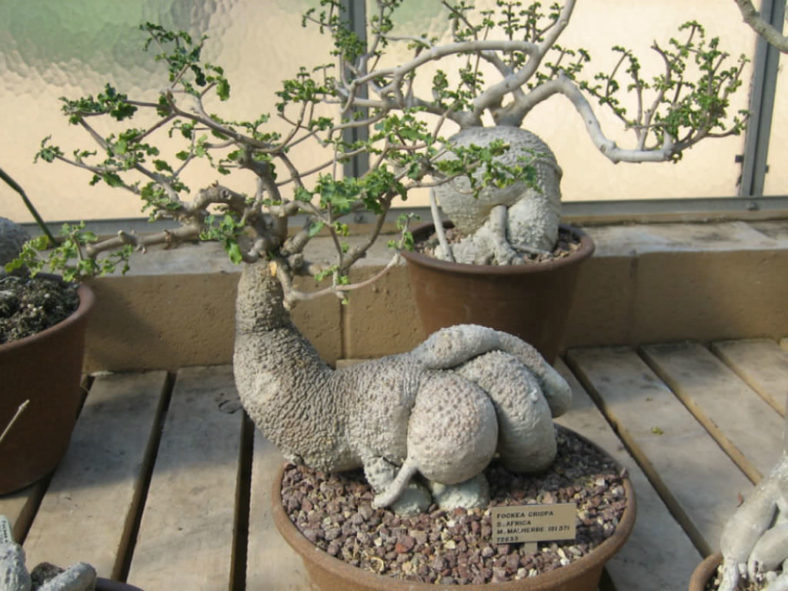Fockea is a genus of 6 succulent scrubs native to southern Africa. It was established by Endlicher in 1838 for the single species, Fockea capensis, based on a specimen cultivated at the Schönbrunn Garden at Schönbrunn Palace in Vienna, Austria. This famous plant had been collected by the explorers sent by Emperor Joseph II of Austria in the Cape Colony sometime after 1786. It is apparently still living today, perhaps the world's oldest potted plant.
The generic name "Fockea" honors the Dutch botanist Charles Focke (1802-1856).
Fockeas have large tuberous roots. In their native regions, the tubers and sometimes other parts of the plant are eaten. The tuber consists of spongy tissue capable of collecting water during the rainy season for the plant to use during the dry season. Some specimens have been found weighing around 100 pounds (45 kg).
Young Fockeas usually grow in the shade of companion plants. As Fockeas mature, they send up erect, straggling, or twining aerial stems that sometimes become so dense they strangle the support plant to death. At other times, when rain is scarce, Fockeas are hardly noticeable in the field, as they usually drop their leaves and branches, leaving the remaining plant underground.

The leaves are simple, opposite, and vary in size and shape between species. Some have entire margins, while others have strongly undulated or crisped margins. Leaves are also variable in many extended populations. Flowers are typically bisexual, greenish-white, and nearly inconspicuous.
Growing Conditions for Fockea
Fockeas are easy-to-grow plants, perfect for beginners interested in caudiciform plants. They can be grown in the ground, but Fockeas are usually seen as potted plants.
Light
These plants prefer partial shade. They can tolerate full sun but need a little sun protection during the hottest part of the day.
Soil
Fast-draining soil mix is the best soil for your Fockea to drain excess water.
Temperature
Fockeas can withstand a light frost. They are cold hardy down to USDA hardiness zones 9b, 25 °F (-3.9 °C).
Pot Size
Choose a container with drainage holes and a depth deep enough to accommodate the rich root system of the plant. For a spectacular tuber, grow your Fockea in a large pot for several years before raising it.
General Care for Fockea
Fockeas are easy to care for because they can store water in their tuber and survive many months without water in hot, arid regions. Provide a trellis, place the plant below a bush, or allow it to vine along a wall or similar structure.
Watering
Water regularly during the growing season, from spring to fall, allowing the soil to dry between waterings. A shriveled tuber is a good indicator that your Fockea may be underwatered. Reduce watering in the winter. Water the plant only enough to prevent the shriveling of the tuber.
Fertilizing
Feed with high-nitrogen fertilizer with a lower potassium level to force tuber growth, but only during the growing season.
Repotting
To encourage tuber development, Fockeas should be repotted once a year. The best time to repot is just after the beginning of the growing season, in late winter or early spring. Always wait a week after repotting to water. The growth of the tuber to a showable size is faster if it is buried in the soil, which can be partly removed for showing.
Pruning
To keep Fockeas looking their best, occasional pruning is recommended. The plants grow easily after pruning.
How to Propagate Fockea
Fockeas are relatively easy to grow from seeds. They are dioecious, so both male and female plants are needed to produce seeds. Sow the seeds in a well-drained mix at about 70 °F (21 °C). The growth of seedlings is rapid but is helped by frequent repotting. Do not underpot young seedlings, as they will slow down their growth. Generally, the roots should only take up the top half of the pot after repotting.
Vegetative propagation is difficult to impossible.
Pests and Diseases of Fockea
Fockeas are generally trouble-free plants, especially when grown outdoors.
Pests
The foliage attracts whiteflies, and periodic spraying with an insecticide may be required to control this problem. Fockeas are also attractive to mealybugs, and the aphid occasionally feeds on young stems.
Diseases
Tubers do not seem especially susceptible to rotting but can collapse suddenly.
Toxicity of Fockea
Fockeas are known as food plants, but the tuber has milky sap, which is said to be poisonous. Avoid contact with skin or eyes, and keep away from children and pets.
Links
- Back to genus Fockea
- Succupedia: Browse succulents by Scientific Name, Common Name, Genus, Family, USDA Hardiness Zone, Origin, or cacti by Genus